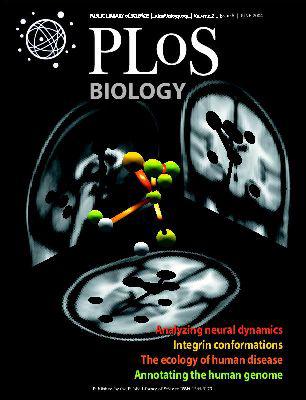Eukaryotic CD-NTase, STING, and viperin proteins evolved via domain shuffling, horizontal transfer, and ancient inheritance from prokaryotes
IF 7.8
1区 生物学
Q1 BIOCHEMISTRY & MOLECULAR BIOLOGY
引用次数: 0
Abstract
Animals use a variety of cell-autonomous innate immune proteins to detect viral infections and prevent replication. Recent studies have discovered that a subset of mammalian antiviral proteins have homology to antiphage defense proteins in bacteria, implying that there are aspects of innate immunity that are shared across the Tree of Life. While the majority of these studies have focused on characterizing the diversity and biochemical functions of the bacterial proteins, the evolutionary relationships between animal and bacterial proteins are less clear. This ambiguity is partly due to the long evolutionary distances separating animal and bacterial proteins, which obscures their relationships. Here, we tackle this problem for 3 innate immune families (CD-NTases [including cGAS], STINGs, and viperins) by deeply sampling protein diversity across eukaryotes. We find that viperins and OAS family CD-NTases are ancient immune proteins, likely inherited since the earliest eukaryotes first arose. In contrast, we find other immune proteins that were acquired via at least 4 independent events of horizontal gene transfer (HGT) from bacteria. Two of these events allowed algae to acquire new bacterial viperins, while 2 more HGT events gave rise to distinct superfamilies of eukaryotic CD-NTases: the cGLR superfamily (containing cGAS) that has diversified via a series of animal-specific duplications and a previously undefined eSMODS superfamily, which more closely resembles bacterial CD-NTases. Finally, we found that cGAS and STING proteins have substantially different histories, with STING protein domains undergoing convergent domain shuffling in bacteria and eukaryotes. Overall, our findings paint a picture of eukaryotic innate immunity as highly dynamic, where eukaryotes build upon their ancient antiviral repertoires through the reuse of protein domains and by repeatedly sampling a rich reservoir of bacterial antiphage genes.真核生物的 CD-NTase、STING 和蝰蛇蛋白是通过结构域洗牌、水平转移和原核生物的古老遗传进化而来的
动物使用多种细胞自主的先天免疫蛋白来检测病毒感染并防止复制。最近的研究发现,哺乳动物抗病毒蛋白的一个子集与细菌中的噬菌体防御蛋白具有同源性,这意味着在生命之树中存在先天免疫的某些方面。虽然这些研究大多集中在描述细菌蛋白质的多样性和生化功能上,但动物和细菌蛋白质之间的进化关系却不太清楚。这种不确定性部分是由于动物和细菌蛋白质之间的进化距离较远,这模糊了它们之间的关系。在这里,我们通过深入采样真核生物的蛋白质多样性来解决3个先天免疫家族(cd - nases[包括cGAS], STINGs和viperins)的这个问题。我们发现蝰蛇和OAS家族cd - nase是古老的免疫蛋白,可能从最早的真核生物出现以来就遗传了。相比之下,我们发现其他免疫蛋白是通过至少4个独立的细菌水平基因转移(HGT)事件获得的。其中两个事件允许藻类获得新的细菌蝰蛇,而另外两个HGT事件产生了真核生物cd - nase的不同超家族:cGLR超家族(包含cGAS)通过一系列动物特异性复制而多样化,以及以前未定义的eSMODS超家族,它更类似于细菌cd - nase。最后,我们发现cGAS和STING蛋白具有本质上不同的历史,STING蛋白结构域在细菌和真核生物中经历了收敛的结构域改组。总的来说,我们的研究结果描绘了真核生物先天免疫的高度动态图景,真核生物通过重复使用蛋白质结构域和反复采样丰富的细菌噬菌体基因库,建立了它们古老的抗病毒能力。
本文章由计算机程序翻译,如有差异,请以英文原文为准。
求助全文
约1分钟内获得全文
求助全文
来源期刊

PLoS Biology
生物-生化与分子生物学
CiteScore
14.40
自引率
2.00%
发文量
359
审稿时长
3 months
期刊介绍:
PLOS Biology is an open-access, peer-reviewed general biology journal published by PLOS, a nonprofit organization of scientists and physicians dedicated to making the world's scientific and medical literature freely accessible. The journal publishes new articles online weekly, with issues compiled and published monthly.
ISSN Numbers:
eISSN: 1545-7885
ISSN: 1544-9173
 求助内容:
求助内容: 应助结果提醒方式:
应助结果提醒方式:


